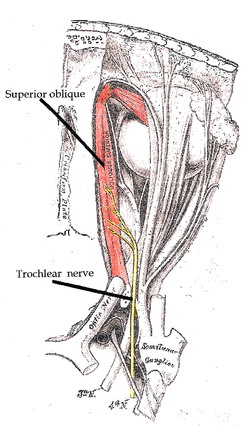Fourth nerve palsy
(Redirected from Trochlear nerve palsy)
Editor-In-Chief: Prab R Tumpati, MD
Obesity, Sleep & Internal medicine
Founder, WikiMD Wellnesspedia &
W8MD medical weight loss NYC and sleep center NYC
| Fourth nerve palsy | |
|---|---|

| |
| Synonyms | Trochlear nerve palsy, Superior oblique palsy |
| Pronounce | N/A |
| Specialty | N/A |
| Symptoms | Vertical diplopia, head tilt, ocular misalignment |
| Complications | Strabismus, amblyopia |
| Onset | Can be congenital or acquired |
| Duration | Varies, can be permanent or temporary |
| Types | N/A |
| Causes | Trauma, vascular disease, congenital defect, tumor |
| Risks | Head injury, diabetes, hypertension |
| Diagnosis | Clinical examination, neuroimaging |
| Differential diagnosis | Third nerve palsy, sixth nerve palsy, thyroid eye disease |
| Prevention | N/A |
| Treatment | Prism glasses, strabismus surgery, observation |
| Medication | N/A |
| Prognosis | Varies, often good with treatment |
| Frequency | Rare |
| Deaths | N/A |
An article about fourth nerve palsy
Fourth nerve palsy, also known as trochlear nerve palsy, is a neurological condition that affects the trochlear nerve (cranial nerve IV), which is responsible for innervating the superior oblique muscle of the eye. This condition can lead to diplopia (double vision) and difficulties with eye movement.
Anatomy
The trochlear nerve is the fourth cranial nerve and is unique in that it is the only cranial nerve that emerges dorsally from the brainstem. It innervates the superior oblique muscle, which is responsible for intorsion, depression, and abduction of the eye.
Causes
Fourth nerve palsy can be congenital or acquired. Congenital cases are often due to developmental anomalies, while acquired cases can result from trauma, microvascular disease, tumors, or aneurysms.
Symptoms
The primary symptom of fourth nerve palsy is vertical diplopia, where the patient sees two images, one above the other. Patients may also experience tilted vision and may adopt a compensatory head tilt to align the images.
Diagnosis
Diagnosis of fourth nerve palsy involves a thorough ophthalmologic examination, including tests for eye movement and alignment. Imaging studies such as MRI or CT scan may be used to identify underlying causes.
Treatment
Treatment options for fourth nerve palsy depend on the underlying cause. In some cases, prism glasses can help alleviate diplopia. Surgical intervention may be necessary to correct muscle imbalance in more severe cases.
Prognosis
The prognosis for fourth nerve palsy varies. Congenital cases may improve over time, while acquired cases depend on the underlying cause and response to treatment.
See also
Transform your life with W8MD's budget GLP-1 injections from $125.
W8MD offers a medical weight loss program to lose weight in Philadelphia. Our physician-supervised medical weight loss provides:
- Most insurances accepted or discounted self-pay rates. We will obtain insurance prior authorizations if needed.
- Generic GLP1 weight loss injections from $125 for the starting dose.
- Also offer prescription weight loss medications including Phentermine, Qsymia, Diethylpropion, Contrave etc.
NYC weight loss doctor appointments
Start your NYC weight loss journey today at our NYC medical weight loss and Philadelphia medical weight loss clinics.
- Call 718-946-5500 to lose weight in NYC or for medical weight loss in Philadelphia 215-676-2334.
- Tags:NYC medical weight loss, Philadelphia lose weight Zepbound NYC, Budget GLP1 weight loss injections, Wegovy Philadelphia, Wegovy NYC, Philadelphia medical weight loss, Brookly weight loss and Wegovy NYC
|
WikiMD's Wellness Encyclopedia |
| Let Food Be Thy Medicine Medicine Thy Food - Hippocrates |
Medical Disclaimer: WikiMD is not a substitute for professional medical advice. The information on WikiMD is provided as an information resource only, may be incorrect, outdated or misleading, and is not to be used or relied on for any diagnostic or treatment purposes. Please consult your health care provider before making any healthcare decisions or for guidance about a specific medical condition. WikiMD expressly disclaims responsibility, and shall have no liability, for any damages, loss, injury, or liability whatsoever suffered as a result of your reliance on the information contained in this site. By visiting this site you agree to the foregoing terms and conditions, which may from time to time be changed or supplemented by WikiMD. If you do not agree to the foregoing terms and conditions, you should not enter or use this site. See full disclaimer.
Credits:Most images are courtesy of Wikimedia commons, and templates, categories Wikipedia, licensed under CC BY SA or similar.
Translate this page: - East Asian
中文,
日本,
한국어,
South Asian
हिन्दी,
தமிழ்,
తెలుగు,
Urdu,
ಕನ್ನಡ,
Southeast Asian
Indonesian,
Vietnamese,
Thai,
မြန်မာဘာသာ,
বাংলা
European
español,
Deutsch,
français,
Greek,
português do Brasil,
polski,
română,
русский,
Nederlands,
norsk,
svenska,
suomi,
Italian
Middle Eastern & African
عربى,
Turkish,
Persian,
Hebrew,
Afrikaans,
isiZulu,
Kiswahili,
Other
Bulgarian,
Hungarian,
Czech,
Swedish,
മലയാളം,
मराठी,
ਪੰਜਾਬੀ,
ગુજરાતી,
Portuguese,
Ukrainian
Contributors: Prab R. Tumpati, MD

